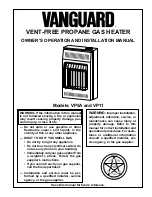
25
Controls—General
Relief Valve
A new combination temperature and pressure (T&P)
relief valve, complying with the Standard for Relief
Valves and Automatic Gas Shut-Off Devices for Hot
Water Supply Systems, ANSI Z21.22, must be
installed in the opening provided on top of the storage
tank at the time of installation. No valve is to be placed
between the relief valve and the storage tank.
The pressure rating of the relief valve must not exceed
the 160 maximum working pressure indicated on the
water heater rating plate. The BTUH rating of the relief
valve must not be less than the BTUH input of the
heater.
Connect the outlet of the relief valve to a suitable open
drain. The discharge line must pitch downward from
the valve to allow complete draining (by gravity) of the
relief valve and discharge line. The discharge line
should be no smaller than the outlet of the valve. The
end of the discharge line should not be threaded or
concealed, and should be protected from freezing. No
valve of any type, restriction or reducer coupling,
should be installed in the discharge line. Local codes
shall govern installation of the relief valve.
Pump Time Delay
There are two versions of the Pump Time Delay. The
first is the Economaster II. It is an electronic device
that allows the operator to set a variable time (3 to 10
minutes) for the pump to run after the heater shuts off.
See Fig. 21 (A). The time is factory-set at 7 minutes
and it can be re-adjusted in the field.
The second version is a fully enclosed solid state TDR
with a white jumper that selects one of two time
delays. See Fig. 21 (B). If the jumper is on pins 6 and
7 (default) the delay time is 5 minutes. If the jumper is
not on pins 6 and 7, the time delay is 10 minutes.
In a conventional system, when the Aquastat is satis-
fied, the main gas valve closes, but the pump
continues operating. With either time delay relay the
heater pump is programmed to continue running for an
optimum period of time in order to absorb the residual
heat from the combustion chamber and use it in the
system. The pump then shuts off until the next call for
heat is received from the Aquastat.
Electronic Ignition
The intermittent ignition device conserves energy by
automatically extinguishing the pilot when desired
temperature is reached. When additional heat is need-
ed, the pilot re-ignites electrically, eliminating the fuel
costs of maintaining a constant pilot. To ensure safe
operation, the gas valve cannot open until the pilot
relights and is confirmed.
Operating Controls
On models 0514-1826, models with mechanical mod-
ulating controls have one or more Robertshaw Unitrol
7000 Series hydraulic snap on thermostatic combina-
tion gas valves. These valves have the pressure
regulator and 24-volt operator built-in. The hydraulic
actuator will throttle the heater input to adjust the firing
rate and meet the required load. This, in effect, pre-
vents costly fuel consumption, as compared to an
NOTE:
Pump will come on when power is first
applied to heater.
Fig. 21: Economaster Time Delay Relays (TDR)
(A)
(B)
Table J: Electronic Ignition
Summary of Contents for WH-0133
Page 2: ...2 Rev 13 reflects the following Changes to Note on Page 13 Item g on Page 18 ...
Page 15: ...15 Fig 9 Indoor Top Installation ...
Page 24: ...24 0 0133 0181 0401 0514 0824 0926 1826 Piping Diagram Type WH Unitemp 80 System ...
Page 28: ...28 Location of Controls 0400 WH1 WH2 WH3 0181 LOW NOx WH1 ...
Page 29: ...29 Location of Controls 0824 ...
Page 38: ...38 WIRING DIAGRAMS Wiring Diagram WH2 0181 0261 ...
Page 39: ...39 Wiring Diagram WH2 0331 0401 ...
Page 40: ...40 Wiring Diagram WH2 0514 0724 ...
Page 41: ...41 Wiring Diagram WH2 0824 1826 ...
Page 42: ...42 Wiring Diagram WH2 2100 2500 ...
Page 43: ...43 Wiring Diagram WH2 3001 4001 ...
Page 48: ...48 ...
Page 50: ...50 ...
Page 51: ...51 ...
















































